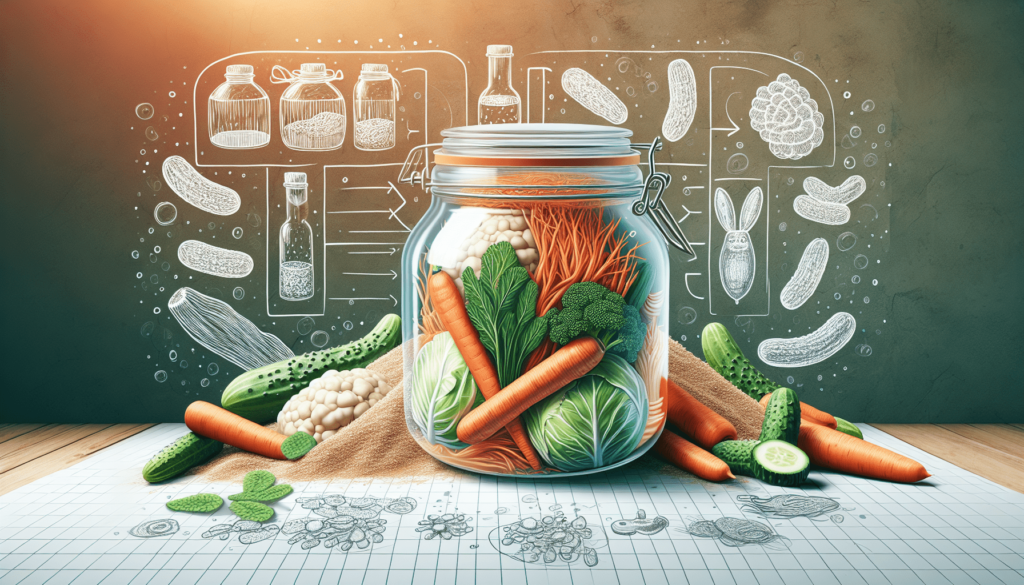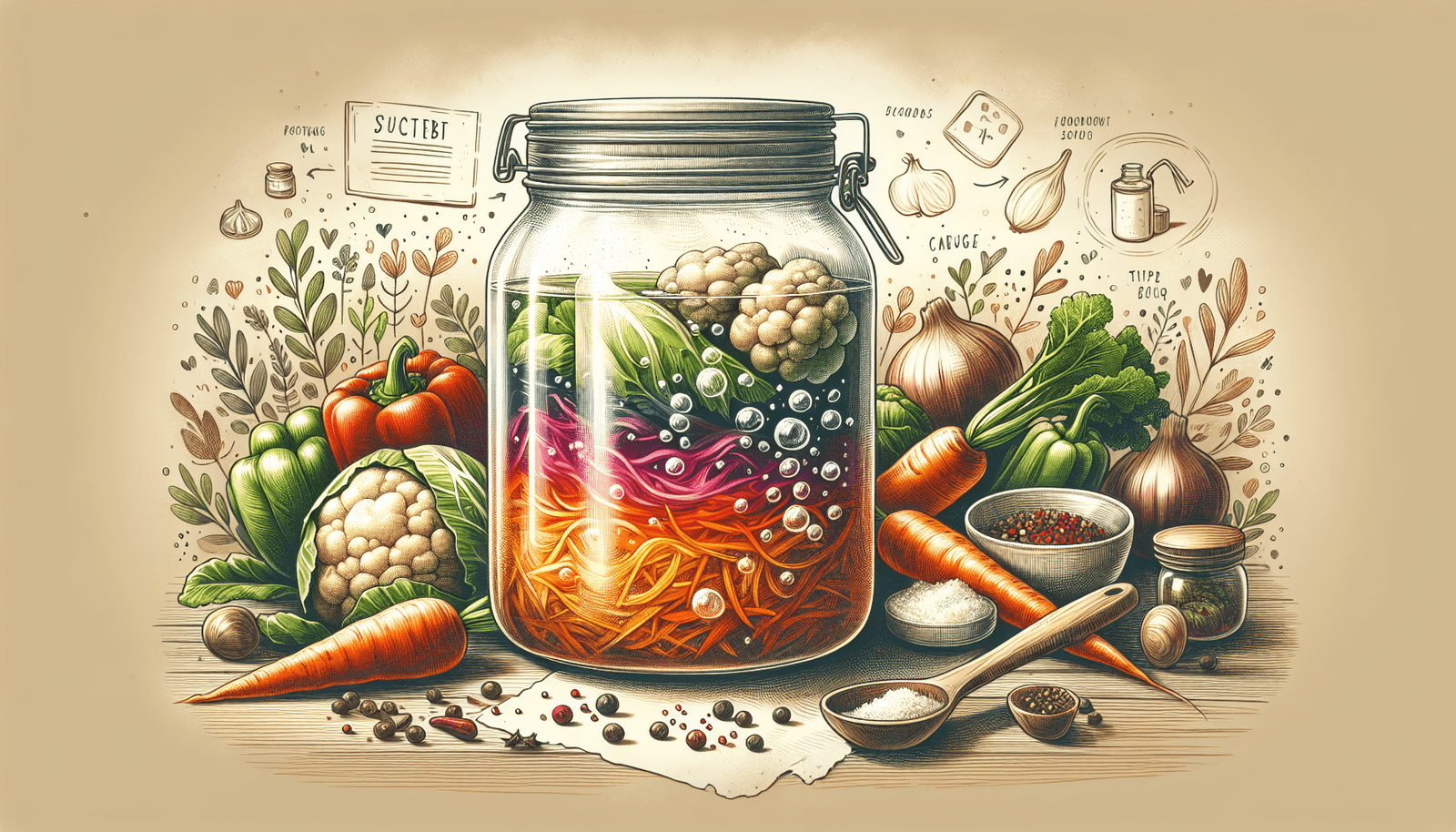Are you ready to embark on a tasty and transformative journey towards improved gut health? Look no further than the exciting world of fermentation! In this article, we will introduce you to the wonders of fermentation and show you how to create three easy DIY fermented foods. From tangy sauerkraut to probiotic-rich kombucha, these simple recipes will not only tantalize your taste buds but also promote a thriving gut microbiome. So, get ready to join the fermentation frenzy and take a step towards a happier and healthier you!

What is fermentation?
Definition of fermentation
Fermentation is a natural process that occurs when microorganisms, such as bacteria, yeast, or fungi, break down carbohydrates in the absence of oxygen. This metabolic process converts sugars into alcohol or organic acids, resulting in the production of fermented foods and beverages.
How fermentation improves gut health
Fermented foods play a crucial role in promoting gut health. The fermentation process increases the bioavailability of nutrients, breaks down complex molecules into more easily digestible forms, and enhances the gut microbiome. By consuming fermented foods, you introduce beneficial bacteria into your digestive system, aiding in digestion and improving overall gut health.
Types of fermented foods
There are numerous types of fermented foods enjoyed worldwide. Some popular examples include sauerkraut, kombucha, kimchi, yogurt, kefir, miso, tempeh, and pickles. Each of these foods undergoes a unique fermentation process, resulting in a distinct flavor profile and health benefits.
Benefits of fermented foods
Promotes gut health
Fermented foods are packed with probiotics, which are beneficial live bacteria that support a healthy gut microbiome. By consuming these probiotics, you replenish and diversify the microbial ecosystem in your gut, promoting optimal digestion and nutrient absorption. A healthy gut is essential for overall well-being and can even have an impact on mental health.
Boosts digestion
The breakdown of complex carbohydrates during fermentation makes them easier for your body to digest. This can be particularly beneficial for individuals with digestive issues, such as bloating, gas, or irritable bowel syndrome. Fermented foods help to regulate bowel movements and promote a healthy gut environment, allowing for better digestion and nutrient extraction.
Enhances nutrient absorption
Fermentation increases the bioavailability of nutrients, making it easier for our bodies to absorb and utilize them. For example, the fermentation of cabbage in sauerkraut increases the levels of vitamin C, K, and various B vitamins. By consuming fermented foods, you can maximize your nutrient intake and ensure that your body can effectively utilize these essential vitamins and minerals.
Strengthens the immune system
The gut is closely linked to the immune system, and maintaining a healthy gut microbiome is crucial for optimal immune function. The probiotics present in fermented foods stimulate the production of immune cells, enhance the body’s natural defense mechanisms, and reduce the risk of infections. Regular consumption of fermented foods can help strengthen your immune system and keep illnesses at bay.
Reduces inflammation
Chronic inflammation is linked to various health conditions, including autoimmune diseases, arthritis, and heart disease. Fermented foods have been shown to possess anti-inflammatory properties, thanks to the beneficial bacteria they contain. By reducing inflammation in the body, fermented foods can help alleviate symptoms and promote overall well-being.
1. Sauerkraut
Ingredients and equipment
To make sauerkraut at home, you will need the following ingredients and equipment:
- 1 medium-sized cabbage
- 1 tablespoon of salt (preferably non-iodized)
- Clean glass jar with a tight-fitting lid
- Weights or a fermentation weight
- Cheesecloth or a fermentation airlock
Step-by-step fermentation process
- Start by shredding the cabbage into thin strips and place it in a large bowl.
- Sprinkle the salt evenly over the cabbage and let it sit for about 10 minutes to allow the salt to draw out the moisture.
- Begin massaging the cabbage with clean hands or a wooden spoon, squeezing it to release more liquid.
- Transfer the cabbage and its liquid into a clean glass jar, packing it tightly and leaving some space at the top.
- Place a fermentation weight or weights on top of the cabbage to keep it submerged in its liquid. Alternatively, you can use a clean zip-lock bag filled with water as a weight.
- Cover the jar with a cheesecloth or attach a fermentation airlock to allow gas to escape during the fermentation process.
- Store the jar in a cool, dark place, away from direct sunlight, and let it ferment for at least 1 to 2 weeks, or until it reaches your desired level of tanginess.
- Once fermented, remove the weights, seal the jar with a tight-fitting lid, and refrigerate your sauerkraut to slow down the fermentation process.
Health benefits of sauerkraut
Sauerkraut is a nutrient-dense food that offers various health benefits:
- It is an excellent source of vitamins C and K, which support collagen production and bone health.
- The fermentation process increases the bioavailability of nutrients in cabbage, making sauerkraut easy to digest and nutrient-rich.
- The lactic acid bacteria in sauerkraut promote a healthy gut microbiome, improving digestion and enhancing overall gut health.
- Sauerkraut contains antioxidants that have been shown to have anti-inflammatory effects, reducing the risk of chronic diseases.
2. Kombucha
Ingredients and equipment
To brew kombucha at home, you will need the following ingredients and equipment:
- 1 SCOBY (Symbiotic Culture of Bacteria and Yeast)
- ½ cup of sugar (preferably organic cane sugar)
- 4 bags of black or green tea
- 8 cups of filtered water
- Glass brewing jar (1-gallon capacity)
- Cheesecloth or a tight-weave cloth
- Rubber band or string
Step-by-step fermentation process
- Boil 4 cups of water in a pot and remove it from heat.
- Add the tea bags to the hot water and steep for about 5 to 10 minutes.
- Remove the tea bags and add the sugar to the hot tea, stirring until completely dissolved.
- Pour the sweetened tea into a clean glass brewing jar and add the remaining 4 cups of filtered water.
- Allow the tea to cool to room temperature.
- Once the tea has cooled, carefully place the SCOBY on top of the liquid.
- Cover the jar with cheesecloth or a tight-weave cloth and secure it with a rubber band or string.
- Place the jar in a warm, well-ventilated area away from direct sunlight.
- Let the kombucha ferment for 7 to 14 days, depending on your desired level of tartness. The fermentation process can take longer in colder temperatures.
- After the initial fermentation period, sample a small amount of the kombucha to taste. If it is to your liking, you can proceed to the next steps. If not, allow it to ferment longer.
- Carefully remove the SCOBY and set it aside for the next batch of kombucha.
- Transfer the fermented kombucha into glass bottles with airtight lids, leaving some space at the top.
- Seal the bottles and let them sit at room temperature for 1 to 3 days for a secondary fermentation, which creates natural carbonation.
- Once the desired level of carbonation is achieved, refrigerate the bottles to slow down the fermentation process and enjoy your homemade kombucha.
Health benefits of kombucha
Kombucha offers several health benefits when consumed as part of a balanced diet:
- It is rich in probiotics, which support a healthy gut microbiome, aid digestion, and promote overall gut health.
- Kombucha contains antioxidants that help reduce inflammation and protect against chronic diseases.
- The fermentation process increases the bioavailability of nutrients, making them easier for the body to absorb.
- It may have detoxifying effects, supporting liver function and aiding in the removal of toxins from the body.
- Consuming kombucha in moderation can contribute to overall hydration and support a healthy immune system.

3. Kimchi
Ingredients and equipment
To make kimchi at home, you will need the following ingredients and equipment:
- 1 Napa cabbage
- ¼ cup of sea salt
- 1 tablespoon of grated ginger
- 3 cloves of garlic, minced
- 1 tablespoon of fish sauce or soy sauce (optional for umami flavor)
- 1 tablespoon of Korean chili pepper flakes (gochugaru)
- 1 small daikon radish, julienned
- 2 green onions, chopped
- Glass jar with a tight-fitting lid
Step-by-step fermentation process
- Cut the Napa cabbage into quarters lengthwise, removing the core. Chop each quarter into bite-sized pieces.
- In a large bowl, dissolve the sea salt in water and submerge the cabbage pieces. Let them sit for about 2 hours, periodically flipping them to evenly salt.
- Rinse the salted cabbage thoroughly under cold running water, removing excess salt.
- In a separate bowl, mix the grated ginger, minced garlic, fish sauce or soy sauce (if using), and Korean chili pepper flakes into a paste.
- Add the julienned daikon radish and chopped green onions to the paste mixture, combining them well.
- Gently squeeze the excess water from the rinsed cabbage and add it to the paste mixture. Mix thoroughly, ensuring all the cabbage is coated.
- Transfer the kimchi mixture to a clean glass jar, packing it down tightly.
- Leave some space at the top of the jar and press the kimchi down with clean hands or a fermentation weight to submerge it in its liquid.
- Seal the jar with a tight-fitting lid.
- Store the jar in a cool, dark place for 3 to 5 days to allow the kimchi to ferment. The fermentation time may vary depending on the desired level of tanginess.
- Once fermented, refrigerate the jar to slow down the fermentation process and enjoy your homemade kimchi.
Health benefits of kimchi
Kimchi offers a range of health benefits, thanks to its fermentation and nutrient-rich ingredients:
- It is rich in fiber and low in calories, making it a great addition to a balanced diet.
- Kimchi is packed with vitamins A, B, and C, as well as minerals like calcium, iron, and potassium.
- The fermentation process increases the bioavailability of nutrients, making them easier to absorb and utilize.
- Kimchi contains lactic acid bacteria, which support a healthy gut microbiome, aid digestion, and enhance overall gut health.
- The beneficial compounds in kimchi, such as antioxidants and fermented by-products, have been linked to reduced inflammation and improved immune function.
Tips for successful fermentation
Choose fresh and organic ingredients
Selecting high-quality, fresh, and organic ingredients is essential for successful fermentation. Fresh produce will have more active beneficial bacteria, resulting in better fermentation outcomes. Organic ingredients can minimize exposure to pesticides, ensuring a cleaner fermentation process.
Use clean equipment and containers
To prevent the growth of harmful bacteria or mold, it is important to use clean equipment and containers for fermentation. Wash all equipment and containers with hot, soapy water before use and rinse them thoroughly. Avoid using antibacterial soap or harsh cleaning agents, as they may interfere with the fermentation process.
Maintain proper temperature and humidity
Different types of fermentation require specific temperature and humidity ranges for optimal microbial activity. It is crucial to maintain these conditions throughout the fermentation process. Keep your fermentation jars in a cool, dark place, away from direct sunlight and extreme temperature fluctuations.
Follow fermentation time guidelines
Each fermented food has its own ideal fermentation time. It is important to follow the guidelines and instructions specific to the food you are fermenting. Under-fermented foods may lack flavor and optimal bacteria counts, while over-fermented foods can become excessively sour or develop off-flavors.
Monitor for signs of spoilage
During the fermentation process, it is important to monitor your fermented foods for any signs of spoilage. Look out for mold growth, foul odors, sliminess, or unusual discoloration. If you notice any of these signs, it is best to discard the batch and start over to avoid potential health risks.
Integrating fermented foods into your diet
Start with small amounts
If you are new to fermented foods, it is advisable to start with small amounts and gradually increase your intake. Your body may need time to adapt to the probiotics and the increased fiber content of fermented foods. Starting with small servings can help prevent any digestive discomfort.
Experiment with different flavors and recipes
There is a wide variety of fermented foods available, each with its own unique flavors and health benefits. Experiment with different types of fermented foods and recipes to find the ones that you enjoy the most. This will make it easier to incorporate them into your daily diet.
Include a variety of fermented foods
To maximize the diversity of beneficial bacteria in your gut, it is important to include a variety of fermented foods in your diet. Try incorporating different types of fermented vegetables, beverages, and dairy products to ensure a diverse range of probiotics.
Pair fermented foods with probiotics
For an extra boost of probiotics, consider pairing your fermented foods with other probiotic-rich foods, such as yogurt or kefir. This combination can provide an even greater diversity of beneficial bacteria and enhance the overall health benefits.
Enjoy fermented foods as condiments or side dishes
Fermented foods can be enjoyed in various ways. They can be incorporated into meals as condiments or side dishes, adding flavor, probiotics, and nutrients. Try adding a scoop of sauerkraut to your sandwich, a spoonful of kimchi to your rice bowl, or a glass of kombucha with your meal.
Considerations and precautions
Allergies and sensitivities
It is important to be aware of any allergies or sensitivities you may have before incorporating fermented foods into your diet. Some fermented foods, such as sauerkraut and kimchi, contain common allergens like cabbage and seafood. If you have any concerns, consult with a healthcare professional or allergist.
Watch out for excessive sodium intake
Certain fermented foods, such as sauerkraut and kimchi, can be high in salt due to the fermentation process. Individuals on a low-sodium diet should monitor their intake of fermented foods to prevent exceeding their recommended sodium levels.
Consult a healthcare professional if necessary
If you have any underlying health conditions or concerns about incorporating fermented foods into your diet, it is always a good idea to consult a healthcare professional. They can provide personalized advice based on your individual circumstances and health needs.
Conclusion
The power of fermented foods for gut health cannot be overstated. These traditional foods have been enjoyed for centuries and offer numerous benefits for our overall well-being. By incorporating homemade fermented foods like sauerkraut, kombucha, and kimchi into your diet, you can improve your gut health, boost digestion, enhance nutrient absorption, strengthen your immune system, and reduce inflammation. Embrace the fermentation frenzy and enjoy the journey to improved well-being through these flavorful and nutrient-rich foods. Remember to start small, experiment with different flavors and recipes, and consult a healthcare professional if needed. So, what are you waiting for? Embrace the world of fermentation and unlock the potential for a healthier gut and a happier you.

